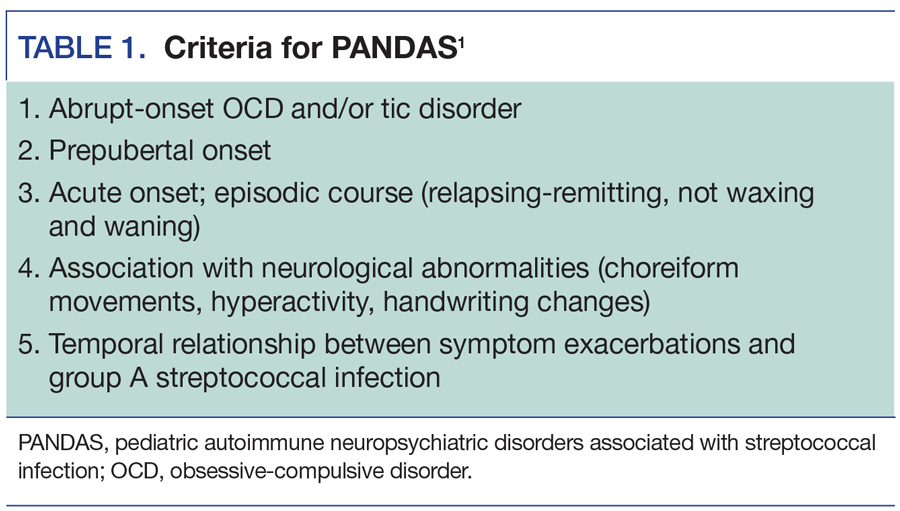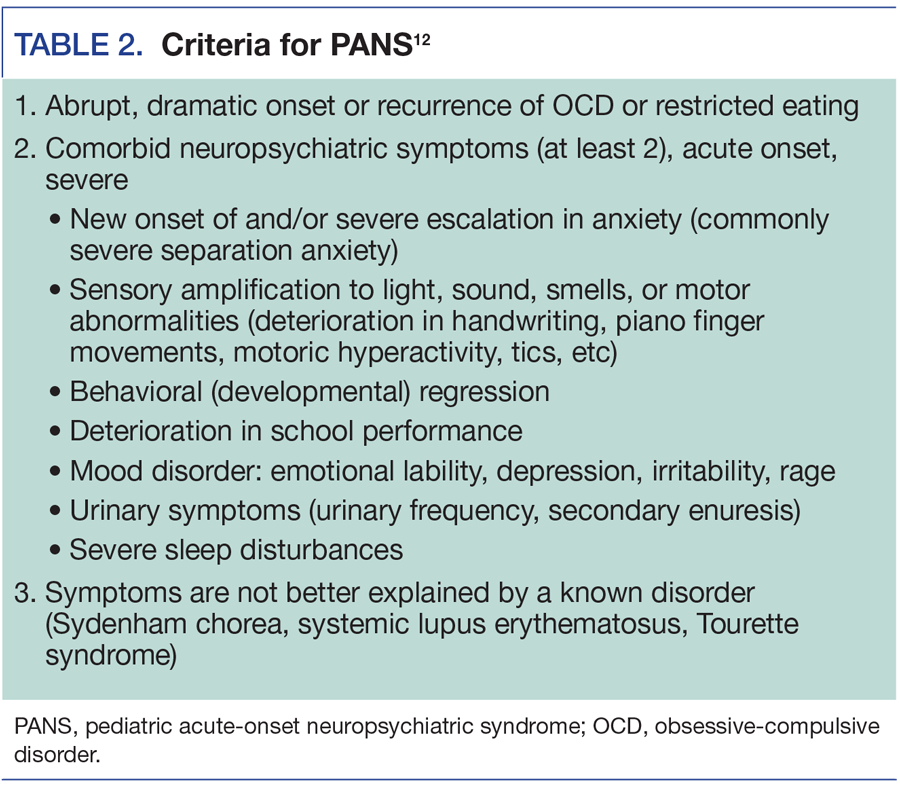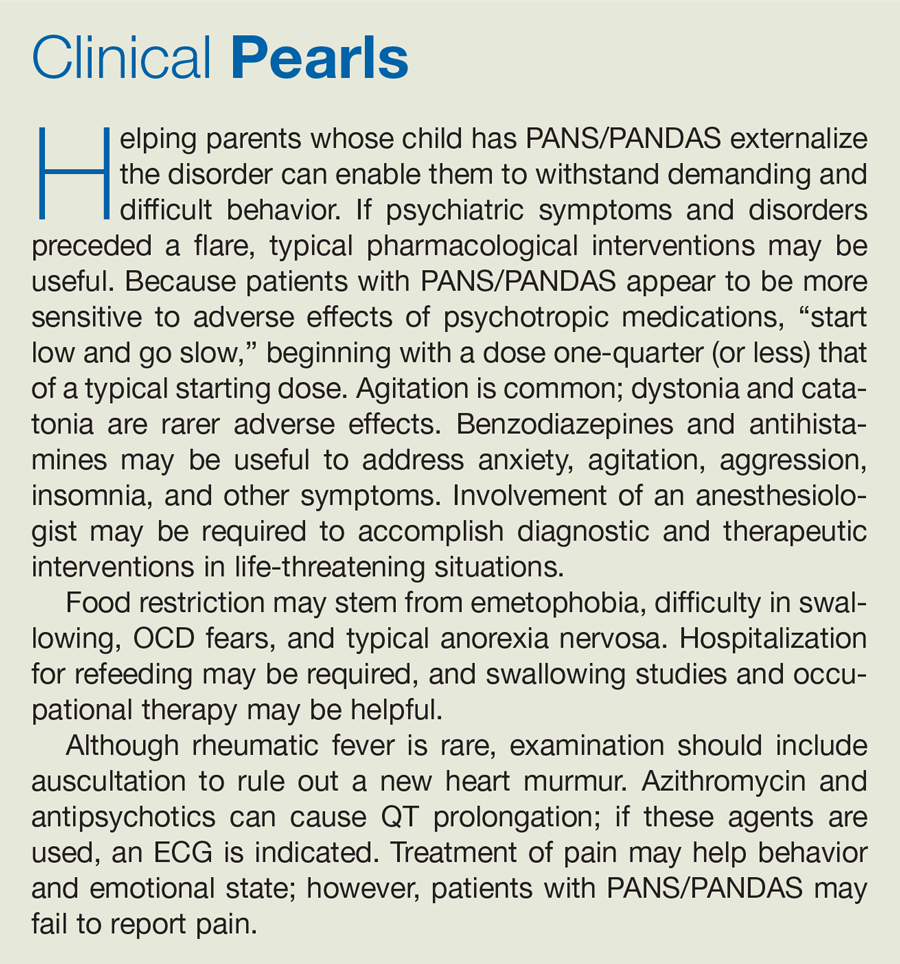Publication
Article
Psychiatric Times
Sudden Onset of Tics, Tantrums, Hyperactivity, and Emotional Lability: Update on PANS and PANDAS
In the neuropsychiatric disorders PANS and PANDAS, we observe childhood illness with relationships between psychiatric symptoms, infection, and inflammation. Here are keys to early identification and treatment.
TABLE 1. Criteria for PANDAS

TABLE 2. Criteria for PANS12

FIGURE. Proposed mechanisms for PANS development in pediatric populations


A previously healthy 7-year-old boy suddenly started blinking, grimacing, and jerking his head about every 10 seconds. Uncharacteristically, he hardly sat still and had a tantrum. Ten days after this abrupt onset of tics, hyperactivity, and emotional lability, his parents took him to the emergency department. The day before the symptoms had started, his primary care physician (PCP) had diagnosed group A streptococcal (GAS) pharyngitis and began treatment with an antibiotic (cefdinir). The PCP also screened the family, which revealed GAS infection in the father and brother.
Physical and laboratory examinations in the ED were unremarkable. The consulting pediatric neurologist diagnosed transient tic disorder and, considering the recent streptococcal infection and the boy’s sudden status change, ordered an MRI scan and referred him to the pediatric acute-onset neuropsychiatric syndrome (PANS) clinic.
The child’s medical history was significant for 11 episodes of sinusitis by age 4, 18 documented upper respiratory tract infections, an episode of parotiditis, and 3 episodes of streptococcal pharyngitis (without tics or behavioral changes).
His mother and siblings frequently had streptococcal infections. His mother underwent tonsillectomy at age 6. His father had a history of obsessive-compulsive disorder (OCD) and tics as well as a family history of Parkinson disease. One of the boy’s siblings had attention-deficit disorder and a speech disorder. His maternal grandmother had a history of acute rheumatic fever, rheumatoid arthritis, and hypothyroidism.
The patient was evaluated in our PANS clinic. After 2 weeks of antibiotic therapy, the tics, irritability, tantrums, difficulty with concentration, and hyperactivity had improved. A physical examination of the oropharynx revealed no tonsillar enlargement or exudate, and no palatal petechiae or erythema. A neurological examination found him calm and cooperative, without tics or piano-playing/choreiform movements (often seen in patients with PANS/ PANDAS [pediatric autoimmune neuropsychiatric disorders associated with streptococcal infection]). He did demonstrate a milkmaid grip, a symptom commonly seen in but not diagnostic of Sydenham chorea. Other neurological soft signs included a slouched posture, consistent with low truncal muscle tone; arm wavering on the Romberg test; and mild overflow dystonia during a stressed walk.
The laboratory evaluation was significant for undetectable antistreptolysin O (ASO) and anti-DNase B titers despite recent GAS infection. Mycoplasma pneumoniae titers were non-reactive. C-reactive protein, immune complex, and immunoglobulin levels were normal. His serum showed adequate post-vaccination responses to pneumococcal pneumonia, tetanus, and Haemophilus influenzae vaccines. His vitamin D level was low. An MRI scan (without specific directions to look for vasculitis) showed minimal mucosal thickening in the ethmoid sinus air cells. An ECG and an echocardiogram were normal. The antibiotic was changed to the narrower-spectrum amoxicillin to treat the GAS infection, and 10 mg/kg of naproxen twice daily was prescribed to address the inflammation thought to underlie his symptoms.
The 2-week follow-up examination revealed mild tics and continued improvement in emotional lability and hyperactivity. The family and the PCP elected to continue naproxen and a prophylactic dose of amoxicillin. Three months later, when his brother contracted GAS pharyngitis, his tics increased. At 6-month follow-up, he was still receiving prophylactic antibiotic therapy and naproxen, and the tics were minimal; however, the boy’s parents noted that when they stopped the naproxen, his symptoms worsened.
Description
The patient’s illness and clinical course meet the criteria for the diagnosis of PANDAS. This postinfectious inflammatory syndrome is diagnosed when a patient has the sudden (some parents can note the hour) and severe onset of OCD or tics, along with 2 other specific psychiatric and neurological symptoms, in the context of recent GAS infection (Table 1).
A constellation of co-occurring changes that appear to be unique to this illness includes both neurological and psychiatric symptoms. Neurological symptoms may include the sudden onset of enuresis or urinary frequency; a sudden decline in handwriting skills and margin drift; development of choreiform movements (piano-playing finger movements observed on the Romberg test); motor hyperactivity; and the sudden and severe onset of sleep disturbances, including REM motor disinhibition, sleep-onset latency, restless sleep, and reverse cycling. Psychiatric presenting symptoms include behavioral regression, anxiety, mood dysregulation, memory and cognitive decline, and sensory amplification. The acuity of the symptoms may be severe: children may exhibit rage episodes, run away, hurt others, refuse to eat, and experience suicidal thoughts and urges.
PANDAS was first described by researchers at the National Institute of Mental Health who were investigating Sydenham chorea and childhood-onset OCD. PANDAS fits under the broader category of PANS and likely represents the most recent manifestation of human/GAS interactions (eg, Sydenham chorea, scarlet fever, rheumatic fever). PANS differs from PANDAS in that the cardinal symptoms are the abrupt and severe onset of OCD and restricted food intake, but the trigger is not known (Table 2). PANS criteria were developed by a consortium to further consistency in research investigation.
The course of PANS and PANDAS follows a sawtooth pattern, with flares following infections and gradual improvements with time and treatment. Flare symptoms may resolve entirely, improve somewhat, or persist. Prompt treatment of each flare and treatment of the earliest flares improve outcomes. If flares are left untreated, the risks of ongoing neuropsychiatric symptoms and chronic inflammatory conditions are likely to increase.
Characteristics
The prevalence of PANS/PANDAS is unknown. Males outnumber females by 2 to 1. Symptoms typically begin between the ages of 6 and 8 years, although onset has been reported from 3 to 17 years.1-3 Families of PANS/PANDAS patients are more likely than the general population to have histories of autoimmune and inflammatory disorders. Infections most commonly implicated include GAS and M pneumoniae infections, sinusitis, and influenza. Even when a trigger is not identified, the sudden and severe onset of OCD or restricted eating along with the specified comorbid symptoms qualifies for a diagnosis of PANS. The stress experienced by families with children who have PANS/PANDAS is thought to exceed that reported by caregivers of patients with Alzheimer disease.4
Mechanisms
Growing research confirms that PANDAS and PANS are inflammatory neuropsychiatric syndromes. Although GAS infection causes about one-quarter of the millions of cases of childhood pharyngitis each year, PANS/PANDAS does not affect most children. Children with PANS/PANDAS are more likely to have a history of immune system dysregulation, including immunodeficiency and autoimmunity. Their families also have more immune system dysregulation than the general population, which manifests as frequent tonsillitis and GAS infections, rheumatic heart disease, arthritis, thyroid disease, and other autoinflammatory and autoimmune disorders, as well as tics and OCD. Although certain infections are more likely to trigger PANS/PANDAS (streptococcal pharyngitis, sinusitis [specific organism unknown], Mycoplasma pneumonia), the specific mechanisms are under investigation by multiple research groups.
There is evidence of CNS inflammation, especially in the basal ganglia, an area of motor and emotion-regulatory neurons, which appears to have a role.5,6 Antineuronal antibodies (lysoganglioside, tubulin, dopamine receptors, CaM kinase II receptor-stimulating) that react with human basal ganglia have been found in patients with Sydenham chorea, Tourette syndrome, and PANDAS.7 Imaging studies in children with PANDAS showed volumetric changes in the basal ganglia and evidence for microglial activation in the basal ganglia (Figure).5,6
Treatment
PANS/PANDAS intervention starts with identifying and treating any triggering infections. Symptoms may respond to anti-inflammatory agents and supportive, behavioral, psychopharmacological, and psychotherapeutic interventions.
Soon after the PANDAS and PANS research criteria were developed, concern emerged that antibiotics might be prescribed for children unnecessarily. (The evidence does not support prophylactic antibiotics for PANDAS as it does for rheumatic fever; however, cautious prophylactic treatment with low-dose antibiotics may be considered for children who have multiple GAS-associated neuropsychiatric exacerbations or recurrences of debilitating symptoms, as well as to minimize the risk of long-term sequelae such as brain injury.)
Such concerns slowed acceptance of the validity of the syndromes. However, appropriate recognition, diagnosis, and judicious treatment based on newly developed guidelines for PANS/ PANDAS have grown, and dedicated PANS clinics have opened at Massachusetts General Hospital (Harvard University); Yale Child Study Center; Stanford University; and the Universities of South Florida, Arizona, Minnesota, and Missouri, and Saskatchewan (Canada). Because established PANS clinics and practitioners cannot accommodate even regional referrals, diagnostic and treatment guidelines have been published to assist community clinicians in treating young patients with PANS/PANDAS.8-11
Rapid GAS screens may miss 15% to 20% of GAS infections; therefore, culture should be performed. Two-week interval changes in, not just elevation of, GAS titers (ASO and DNase B) indicate recent GAS infection. Many children without PANS/PANDAS have elevated titers, and some children with PANS/PANDAS and GAS infection do not demonstrate positive titers. GAS can affect the perianal and vaginal areas; if redness, itching, and discharge are present, culture for GAS. Children with PANS/PANDAS can react to others’ GAS infection or carrier state; screen family members and close contacts for GAS.
Sinusitis and M pneumoniae infection are frequent triggers. (See Chang and colleagues8 for complete evaluation recommendations.) Infections should be treated according to standard pediatric practice. Tonsillectomy and adenoidectomy should be performed according to pediatric otolaryngology guidelines. (See Cooperstock and colleagues11 for complete PANS/PANDAS infectious disease recommendations.)
Once underlying infections are identified and treatment has begun, immunomodulatory interventions may be considered, tailored to disease severity and clinical course. Before immunomodulatory treatments are initiated, other inflammatory/immune conditions, such as immunodeficiency and acute encephalitis, should be considered. While the treatment of infections follows standard pediatric practice, current immunomodulatory guidelines derive from pooled expert consensus, limited research, and extrapolation from related inflammatory illnesses.
For mild disease, retrospective clinical data support the use of NSAIDs and brief oral corticosteroid bursts (akin to the treatment of asthma flares). These data suggest that each intervention can decrease the length of the flare and that the sooner the intervention is begun, the shorter the flare. Before corticosteroids are initiated, occult infections such as tuberculosis and fungal diseases should be ruled out. Note that corticosteroids may temporarily exacerbate emotional and behavioral symptoms.
For moderate to severe disease, more prolonged or aggressive corticosteroid treatment, intravenous pooled human immunoglobulin (IVIG) therapy, or both may help. For extreme to life-threatening disease, plasma exchange (plasmapheresis) or intravenous corticosteroids plus IVIG may be indicated. Consultation with a pediatric rheumatologist is recommended if rituximab, cyclophosphamide, or other therapies used to treat inflammatory brain disease are being considered.10
Children and adolescents with a PANS/PANDAS flare may be extremely disruptive; they may have symptoms of OCD, mood lability and rage attacks, separation anxiety, life-threatening food and liquid restriction, oppositionality, sleep cycle reversal, fatigue, and pain. They may appear willful, but they are quite ill. At a minimum, symptoms must be managed for safety so that the child can comply with and receive treatments. Families must learn behavioral strategies and crisis management and refrain from accommodating OCD.
The most effective psychopharmacological intervention may be treatment of underlying infection and/or inflammation. Responses to temporary symptom exacerbations amidst treatment with other medical interventions should be confined to those intended to control dangerous or therapy-interfering behavior temporarily. Hospitalization may be required for suicidal and other dangerous behaviors and failure to eat or drink sufficiently.9
New PANS/PANDAS psychiatric symptoms are likely caused by inflammation and may not respond to psychopharmacological interventions in the same way that garden-variety psychiatric diseases respond to these medications. Because symptoms change episodically and with concomitant antibiotic and immunological interventions, distinguishing the effects of other medications is difficult. Simultaneous treatments for infection, inflammation, and emotional symptoms can make it difficult to discern responses to pharmacological therapy from the other interventions.
Interdisciplinary collaboration and challenges to care
Coordination of care between multiple medical subspecialists is necessary in the evaluation and treatment of patients with PANS/PANDAS and presents a significant challenge. There are a handful of established multidisciplinary clinics in which primary care providers, immunologists, rheumatologists, infectious disease specialists, child psychiatrists, and psychotherapists work together.
Consultation with otolaryngology, neurology, sleep medicine, and neuroradiology subspecialists is frequently needed. Patients who require infusions or imaging under sedation or on a monitored floor need the involvement of a hospitalist, an intensive care clinician, and an anesthesiologist. Most practitioners who encounter PANS/PANDAS will face challenges in coordinating care with physicians outside their specialty. When practitioners develop an informal referral network and share patients with regularity, those challenges are lessened.
Most children will miss some school and will require accommodations. Designing accommodations for fluctuating symptoms poses difficulties because most educational plans are written to address relatively tonic symptoms. Educating all personnel who interact with the youth about the nature of PANS/PANDAS is necessary, as ADHD, separation anxiety, OCD, fatigue, reduced cognitive processing speed, memory difficulties, loss of math and reading skills, new-onset handwriting difficulty, and frequent urination can all affect learning.
Finally, when more aggressive immunomodulatory therapies are needed, securing insurance approval may be time-consuming and difficult. In addition, since there are few pediatric medical-psychiatric facilities, finding pediatric hospital wards that can accommodate both the medical interventions (eg, imaging, infusions) and the need to keep patients and staff safe from disruptive behaviors can be challenging. Psychiatric wards that accommodate young children and deliver medical interventions are uncommon.
Families carry most of the burden of managing children during a PANS/PANDAS flare. Regional and national PANS/PANDAS support organizations have developed in the US and abroad. Online resources for physicians (PANDASppn.org) and parents (PANDASnetwork.org) have been developed, supported by charitable donations.
Conclusion
PANS and PANDAS are neuropsychiatric disorders in which we can observe childhood illness with relationships between psychiatric symptoms, infection, and inflammation. Early identification and treatment improve the course of illness and its immediate and, likely, long-term impact. Current treatment derives from standard pediatric infectious disease as well as immunological and psychiatric practice, but research about its underlying mechanisms, characteristics, and treatment is growing rapidly. We are optimistic that learning about PANS/PANDAS will help lead to other discoveries in the causal mechanisms of psychiatric disorders.
Disclosures:
Dr. Thienemann is Clinical Professor of Psychiatry, Stanford University School of Medicine, and Co-Director of the PANS Program, Stanford Children’s Health, Palo Alto, CA. Dr. Frankovich is Clinical Associate Professor, in the Department of Pediatric Rheumatology, and Co-Director of the PANS Program, Stanford University School of Medicine, Palo Alto, CA.
Dr. Thienemann reports no conflicts of interest concerning the subject matter of this article.
References:
1. Swedo SE, Leonard HL, Garvey M, et al. Pediatric autoimmune neuropsychiatric disorders associated with streptococcal infections (PANDAS): clinical description of the first 50 cases. Am J Psychiatry. 1998;155:264-271.
2. Murphy TK, Patel PD, McGuire JF, et al. Characterization of the pediatric acute-onset neuropsychiatric syndrome phenotype. J Child Adolesc Psychopharmacol. 2015;25:14-25.
3. Frankovich J, Thienemann M, Pearlstein J, et al. Multidisciplinary clinic dedicated to treating youth with pediatric acute-onset neuropsychiatric syndrome: presenting characteristics of the first 47 consecutive patients. J Child Adolesc Psychopharmacol. 2015;25:38-47.
4. Mahony T, Brown K, Pearlstein J, et al. Caregiver burden in parents of patients with pediatric acute-onset neuropsychiatric syndrome (PANS). Presented at: 23rd Annual OCD Conference; July 29-31, 2016; Chicago, IL.
5. Giedd JN, Rapoport JL, Garvey MA, et al. MRI assessment of children with obsessive-compulsive disorder or tics associated with streptococcal infection. Am J Psychiatry. 2000;157:281-283.
6. Kumar A, Williams MT, Chugani HT. Evaluation of basal ganglia and thalamic inflammation in children with pediatric autoimmune neuropsychiatric disorders associated with streptococcal infection and Tourette syndrome. J Child Neurol. 2015;30: 749-756.
7. Cutforth T, Demille MMC, Agalliu I, Agalliu D. CNS autoimmune disease after Streptococcus pyogenes infections: animal models, cellular mechanisms and genetic factors. Future Neurol. 2016;11:63-76.
8. Chang K, Frankovich J, Cooperstock M, et al. Clinical evaluation of youth with pediatric acute-onset neuropsychiatric syndrome (PANS): recommendations from the 2013 PANS Consensus Conference. J Child Adolesc Psychopharmacol. 2015;25:3-13.
9. Thienemann M, Murphy T, Leckman J, et al. Clinical management of pediatric acute-onset neuropsychiatric syndrome, part 1: psychiatric and behavioral interventions. J Child Adolesc Psychopharmacol. 2017. In press.
10. Frankovich J, Swedo SE, Hernandez J, et al. Clinical management of pediatric acute-onset neuropsychiatric syndrome, part 2: use of immunomodulatory therapies. J Child Adolesc Psychopharmacol. 2017. In press.
11. Cooperstock M, Murphy TK, Pasternack M, Swedo SE. Clinical management of pediatric acute-onset neuropsychiatric syndrome (PANS), part 3: treatment and prevention of infections. J Child Adolesc Psychopharmacol. 2017. In press.
12. Swedo S, Leckman JF, Rose NR. From research subgroup to clinical syndrome: modifying the PANDAS criteria to describe PAS (pediatric acute-onset neuropsychiatric syndrome. Pediatr Therapeut. https://www.omicsonline.org/from-research-subgroup-to-clinical-syndrome-modifying-the-pandas-criteria-to-describe-pans-(pediatric-acute-onset-neuropsychiatr.pdf. Accessed February 21, 2017.






